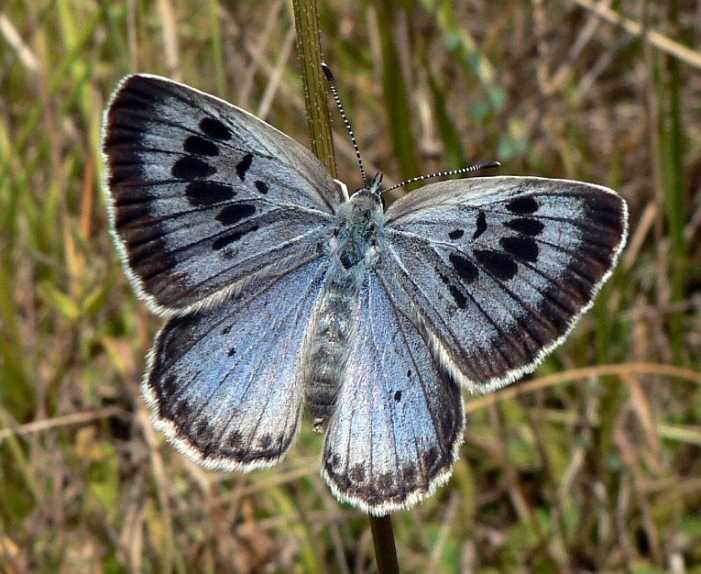Large blue; Credit: PJC&Co by a Creative Commons Licence
The red queen theory of evolution concerns organisms that have to adapt continuously in order to combat co-evolving species. On the other hand, the red king
hypothesis has revealed mutualists providing a little too much to their partners, which would of course come as a shock to those of us who see nature red in tooth and claw.
The Lycaenids or blues are a butterfly family with cosmopolitan distribution, but each region has its own species groups. They have evolved quite recently, 30% linking up symbiotically with ants (myrmecophily.) They protect the ants or provide sugars just like the greenfly ant-cows
but that is not always the case. Parasitism has evolved from mutualism many times, and the bloodthirsty caterpillars of some blues are no different. Some go so far as eating the aphids that belong to the ant nest, as well as their brood! The obligate species stay with only one or two ant species while the loosely-connected can use up to 11. For the blues, this unique association has spelled out great diversity of form and physiologies, even when the anatomy is similar.
It’s fascinating to think that the typical insect predator is itself being predated by a caterpillar, though many species don’t eat only ant larvae/ ants. With a large set of data, Sa¨mi Scha¨r of Copenhagen and Harvard Universities and his Swiss and German colleagues have looked into the blues genetic structure and its relationship to their ecological specialisations. 967 species were analysed, which illustrates the diversity in itself. Some eat plants only, some predate ants only and others have independently speciated into omnivory. The intricate paper can be found in The Proceedings of the Royal Society B.
Great diversity was found among those herbivores that specialise on one plant only. However, the carnivorous species showed greater Isolation By Distance (IBD) in their measurements, further increasing as they became even more specialised. As would be expected some of these extremists had reduced population sizes, compared to more generalist feeders. Diversification seems to be driven by occurrence of appropriate ants, but also by distance/biogeographical barriers. The most extreme blues can use ants as a cue for egg-laying, so their host plant range could thereby be increased leading to even more niches and greater diversification over time.
Within the DNA, molecular substitution rates were very high in strict carnivores. Perhaps this means fragmentation and reduction in populations are taking place when environments change due to climate or disturbance. Where specialised blues had both food plant and attendant ants, divergence was limited, surprisingly indicating that several evolutionary dead-ends could have been reached.
We seem to have red queen situations in ant/butterfly relationships, but the poor old red king
hypothesis has gathered little substance here, just as the ant males disappear quickly after mating!










